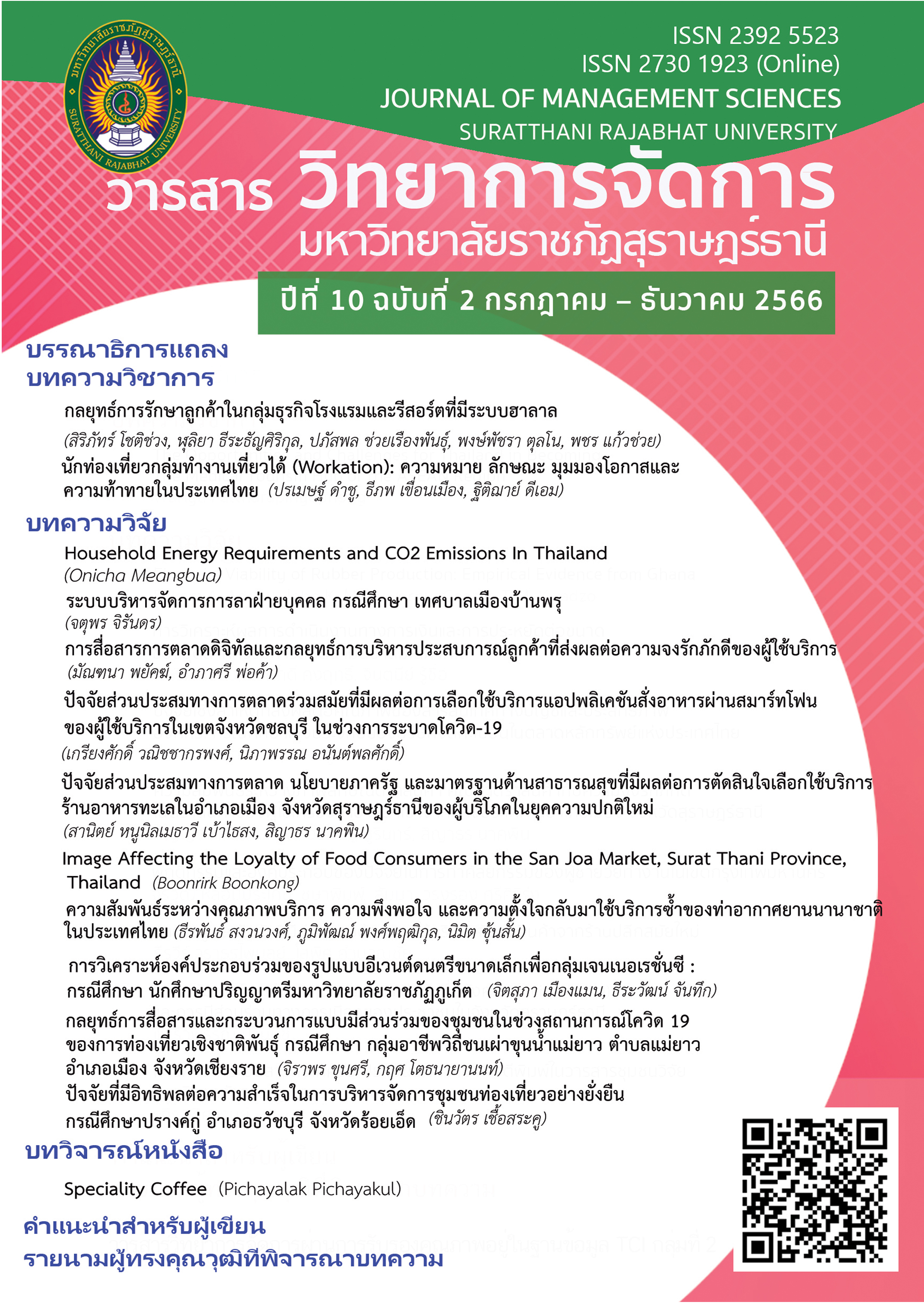Contemporary Marketing Mix Factors Affecting User in Chonburi Province Intention to Use Smartphone Food Ordering Apps During COVID-19 Pandemic
Main Article Content
Abstract
The covid-19 epidemic situation has brought changes to people's lifestyles. Food delivery applications (FDA) are now trending in the marketplace and more and more application providers are emerging in the food industry. Therefore, the research purpose of this study is to analyze the contemporary marketing mix (7C’s) factors affecting users in Chonburi province intention to use smartphone Food Ordering Apps during COVID-19 pandemic. This study was quantitative research and used questionnaires as tools for data collection from a sample consisting of 400 food delivery service users in Chonburi Province through online survey. The methodology of this study was the quantitative method by descriptive statistics and multiple regression analysis. The findings showed that consumer’s personal factors do not influence the choice of Food Ordering Applications. the majority of users choose GrabFood, followed by LineMan. Contemporary marketing mix (7C’s) factors affecting users in Chonburi province intention to use Food Ordering Applications during COVID-19 pandemic had a multiple correlation coefficient (R) 0.307. Considering each factor, it was found that the Caring factor influence users intention to use Food Ordering Applications the most (Sig = 0.001), follow by “Comfort factor”
(Sig = 0.007) statistically significant at the 0.05 level. Customer value factor, Cost factor, Convenience factor, Communication factor and Completion factor do not influence user in Chonburi province intention to use Food Ordering Applications during COVID-19 pandemic.
Article Details

This work is licensed under a Creative Commons Attribution-NonCommercial-NoDerivatives 4.0 International License.
References
Baltas, G., Argouslidis, P. C., & Skarmeas, D. (2010). The role of customer factors in multiple store patronage: A Cost-Benefit approach. Journal of Retailing, 86(1), 37-50. https://doi.org/10.1016/j.jretai.2010.01.005.
Burlea-Schiopoiu, A., Puiu, S., & Dinu, A. (2021). The impact of food delivery applications on Romanian consumers’ behavior during the COVID-19 pandemic. Socio-Economic Planning Sciences, Article 101220. https://doi.org/10.1016/j.seps.2021.101220.
Cho, M., Bonn, M. A., & Li, J. (2019). Differences in perceptions about food delivery apps between single-person and multi-person households. International Journal of Hospitality Management, 77, 108-116. https://doi.org/10.1016/j.ijhm.2018.06.019.
Cronbach, L. J., (1990). Essentials of Psychological Testing. Harper & Row.
Department of Disease Control. (2022, April 10). COVID-19 Dashboard. https://ddc.moph.go.th/covid19-dashboard/?dashboard=main.
Fakfare, P. (2021). Influence of service attributes of food delivery application on customers' satisfaction and their behavioural responses: The IPMA approach. International Journal of Gastronomy and Food Science, 25, Article 100392. https://doi.org/10.1016/j.ijgfs.2021.100392.
Grabara, D. (2021). iPhone 11 premium mobile device offers on e-commerce auction platform in the context of Marketing Mix framework and COVID-19 pandemic. Procedia Computer Science, 192, 1720-1729. https://doi.org/10.1016/j.procs.2021.08.177.
Jobber, D. (2013). Principles and Practice of Marketing (7th ed.). McGraw Hill Higher Education.
Kapoor, A. P., & Vij, M. (2018). Technology at the dinner table: Ordering food online through mobile apps. Journal of Retailing and Consumer Services, 43, 342-351. https://doi.org/10.1016/j.jretconser.2018.04.001.
Kasikorn Research Center. (2020, November 16). Guidelines for Food Delivery Businesses. https://kasikornresearch/com/en/analysis/k-social-media/Pages/Food-Delivery-FB-10-11-20.aspx.
Kerdngern, N., Kamthornphiphatthanakul, S., & Somthong, N. (2021). Effects of Innovation Adoption Factors on Purchase Intention in Online Food Delivery in Thailand. Journal of Business Administration Maejo University, 3(2), 1-19. https://doi.org/10.14456/mjba.2021.6.
Khazanie, R. (1986). Elementary statistics in a world of applications. Harper Collins.
Kotler, P. (2001). Marketing Management (Millenium ed.). Pearson Custom Publishing.
Li, L., & Wang, D. (2022). Do neighborhood food environments matter for eating through online-to offline food delivery services? Applied Geography, 138, Article 102620. https://doi.org/10.1016/j.apgeog.2021.102620.
Lim, X. J., Cheah, J. H., Ng, S. I., Basha, N. K., & Soutar, G. (2021). The effects of anthropomorphism presence and the marketing mix have on retail app continuance use intention. Technological Forecasting and Social Change, 168, Article 120763. https://doi.org/10.1016/j.techfore.2021.120763.
Lovelock, C. H., Wirtz, J., & Chatterjee, J. (2007). Services Marketing, People, Technology, Strategy. Prentice-Hall.
Lunkam, P. (2021, February 24). Industry Outlook 2021-2023: Hotel Industry. https://www.krungsri.com/en/research/industry/industry-outlook/Services/Hotels/IO/io-hotel-21
Ponpitak, P., Busaban, K, Emin, T., & Martsiri, A. (2021). Technology Acceptance Affecting Food Order Intention Via Application of Employee in Laem Chabang Industrial Estate Chonburi. Journal of Graduate School of Commerce-Burapha Review, 16(2), 45–57.
Purohit, S., Paul, J., & Mishra, R. (2021). Rethinking the bottom of the pyramid: Towards a new marketing mix. Journal of Retailing and Consumer Services, 58, Article 102275. https://doi.org/10.1016/j.jretconser.2020.102275.
Shimizu, K. (2014). Advertising Theory and Strategies (18th ed.). Souseisha Book Company.
Similarweb. (2022, February 11). Top Free Food & Drink iPhone Apps in App Store in Thailand. https://www.similarweb.com/apps/top/apple/store-rank/th/food-drink/top-free/iphone
Vig, S., & Agarwal, R. N. (2021). Repercussions of COVID‐19 on small restaurant entrepreneurs: The Indian context. Strategic Change, 30(2), 145–152. https://doi.org/10.1002/jsc.2398
Yeo, V. C. S., Goh, S. K., & Rezaei, S. (2017). Consumer experiences, attitude and behavioral intention toward online food delivery (OFD) services. Journal of Retailing and Consumer Services, 35, 150-162. https://doi.org/10.1016/j.jretconser.2016.12.013
Zaina, L. A. M, Fortes, R. P. M, Casadei, V., Nozaki, L. S., & Paiva, D. M. (2022). Preventing accessibility barriers: Guidelines for using user interface design patterns in mobile applications. Journal of Systems and Software, 186, Article 111213. https://doi.org/10.1016/j.jss.2021.111213.


